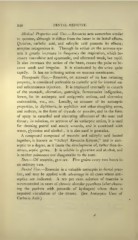Page 542 - My FlipBook
P. 542
540 DENTAL MEDICINE.
Medical Properties and Uses.— Resorcin acts somewhat similar
to quinine, although it differs from the latter in its lethal effects.
Quinine, carbolic acid, and salicylic acid promote its effects;
atropine antagonizes it. Through its action on the nervous sys-
tem it greatly increases in frequency the respiration, which be-
comes convulsive and spasmodic, and afterward weak, but rapid.
It also increases the action of the heart, causes the pulse to be-
come weak and irregular. It is eliminated by the urine quite
rapidly. It has no irritating action on mucous membranes.
Therapeutic Uses.— Resorcin, on account of its less irritating
property, is considered preferable to carbolic acid for internal use
and subcutaneous injection. It is employed internally in catarrh
of the stomach, ulceration, gastralgia, fermentative indigestion,
fevers, for its antiseptic and antipyretic actions, and ulcerative
endocarditis, etc., etc. Locally, on account of its antiseptic
properties, in diphtheria, in syphilitic and other sloughing sores,
and anthrax, in the form of crystals or powder, and in the form
of spray in catarrhal and ulcerating affections of the nose and
in solution, on account of its antiseptic action, it is used
throat ;
for dressing putrid and atonic wounds, and is combined with
water, glycerine and alcohol ; it is also used in pomades.
A compound composed of resorcin and salicylic acid heated
together, is known as " Salicyl Resorcin-Ketone," and is anti-
septic to a degree, as it limits the development of, rather than de-
stroys, septic germs. It is soluble in glycerine and alcohol, and
is neither poisonous nor disagreeable to the taste.
Dose.—Of resorcin, gr.v—xv. Five grains every two hours in
an ordinary case.
Dental Uses.—Resorcin is a valuable antiseptic in dental prac-
tice, and may be applied with advantage in all cases where anti-
septics are indicated. A ten per cent, solution of resorcin is
recommended in cases of chronic alveolar pyorrhoea (after cleans-
ing the pockets with peroxide of hydrogen) where there is
impaired circulation of the tissues. (See Antiseptic Uses of
Carbolic Acid.)


